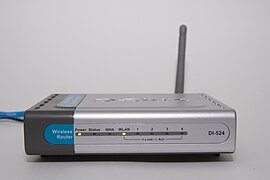Wireless router: Difference between revisions
→Features: cited 9 year old standards as "modern". Listed 4 year old standard and changed "at most" to "exceeding" |
→Notable manufacturers: writing "world market leader" for linksys is more like an advertisement. No need. |
||
| Line 31: | Line 31: | ||
# [[D-Link]] |
# [[D-Link]] |
||
# [[HP Inc.]] |
# [[HP Inc.]] |
||
# [[Linksys]] |
# [[Linksys]] |
||
# [[MikroTik]] |
# [[MikroTik]] |
||
# [[Motorola]] |
# [[Motorola]] |
||
Revision as of 18:44, 22 December 2017
This article needs additional citations for verification. (September 2014) |



A wireless router is a device that performs the functions of a router and also includes the functions of a wireless access point. It is used to provide access to the Internet or a private computer network. Depending on the manufacturer and model, it can function in a wired local area network, in a wireless-only LAN, or in a mixed wired and wireless network.
Features
Most current wireless routers have the following characteristics:
- One or multiple NICs supporting Fast Ethernet or Gigabit Ethernet integrated into the main SoC
- One or multiple WNICs supporting a part of the IEEE 802.11-standard family also integrated into the main SoC or as separate chips on the printed circuit board. It also can be a distinct card connected over a MiniPCI or MiniPCIe interface.
- So far the PHY-Chips for the WNICs are generally distinct chips on the PCB. Dependent on the mode the WNIC supports, i.e. 1T1R, 2T2R or 3T3R, one WNIC have up to 3 PHY-Chips connected to it. Each PHY-Chip is connected to a Hirose U.FL-connector on the PCB. A so-called pigtail cable connects the Hirose U.FL either to a RF connector, in which case the antenna can be changed or directly to the antenna, in which case it is integrated into the casing. Common are single-band (i.e. only for 2.4 GHz or only for 5 GHz) and dual-band (i.e. for 2.4 and 5 GHz) antennas.
- Often an Ethernet switch supporting Gigabit Ethernet or Fast Ethernet, with support for IEEE 802.1Q, integrated into the main SoC (MediaTek SoCs) or as separate Chip on the PCB.
- Some wireless routers come with either xDSL modem, DOCSIS modem, LTE modem, or fiber optic modem integrated.
- IEEE 802.11ac compliant or ready.
- Some dual-band wireless routers operate the 2.4 GHz and 5 GHz bands simultaneously.
- Many dual-band wireless routers have data transfer rates exceeding 300 Mbit/s (For 2.4 GHz band) and 450 Mbit/s (For 5 GHz band).[1]
- The Wi-Fi clone button simplifies Wi-Fi configuration and builds a seamless unified home network, enabling Super Range Extension, which means it can automatically copy the SSID and Password of your router.[2]
- Some wireless routers have one or two USB ports. For wireless routers having one USB port, it is designated for either printer or desktop/mobile external hard disk drive. For wireless routers having two USB ports, one is designated for the printer and the other one is designated for either desktop or mobile external hard disk drive.[3]
- Some wireless routers have a USB port specifically designed for connecting mobile broadband modem,[4] aside from connecting the wireless router to an Ethernet with xDSL or cable modem. So, can be inserted a mobile broadband USB adapter into the router to share the mobile broadband Internet connection through the wireless network.
Notable manufacturers
- Apple Inc.
- Arris
- Asus
- Belkin
- Buffalo Technology
- Cisco
- D-Link
- HP Inc.
- Linksys
- MikroTik
- Motorola
- Netgear
- Swisscom
- TP-Link
- Ubiquiti Networks
Operating system
The most common operating system on such embedded devices is Linux. More seldomly, VxWorks is being used. The devices are configured over a web user interface served by a light web server software running on the device.
It is possible for a computer running a desktop operating system such as Windows to, with appropriate software, act as a wireless router. This is commonly referred to as a SoftAP, or "Software Access Point" (aka "virtual router").
Open source firmware
In 2003, Linksys was forced to open-source the firmware of its WRT54G router series (the best-selling routers of all time) after people on the Linux Kernel Mailing List discovered that it used GPL Linux code.[5] In 2008, Cisco was sued in Free Software Foundation, Inc. v. Cisco Systems, Inc due to similar issues with Linksys routers.
Since then, various open-source projects have built on this foundation, including OpenWrt, DD-WRT, and Tomato.
In 2016, various manufacturers changed their firmware to block custom installations after an FCC ruling.[6] However, some companies plan to continue to officially support open-source firmware, including Linksys[7] and Asus.[6]
See also
Notes
References
- ^ What Is WiFi? Archived 2015-12-01 at the Wayback Machine
- ^ 300Mbps AV500 WiFi Powerline Extender Starter Kit Archived 2014-11-04 at the Wayback Machine
- ^ "What is portable WiFi router and how to use one". www.worldsim.com. WorldSIM. Retrieved 9 May 2016.
- ^ D-Link® Mobile Broadband Wireless Router (DIR-412) Archived 2014-08-03 at the Wayback Machine
- ^ "The Open Source WRT54G Story". www.wi-fiplanet.com. Archived from the original on 2016-06-04. Retrieved 2016-10-05.
{{cite web}}: Unknown parameter|deadurl=ignored (|url-status=suggested) (help) - ^ a b "Despite New FCC Rules, Linksys, Asus Say They'll Still Support Third Party Router Firmware". Archived from the original on 2016-10-05. Retrieved 2016-10-05.
{{cite web}}: Unknown parameter|deadurl=ignored (|url-status=suggested) (help) - ^ "Linksys WRT routers won't block open source firmware despite FCC rules". Archived from the original on 2016-10-04. Retrieved 2016-10-05.
{{cite web}}: Unknown parameter|deadurl=ignored (|url-status=suggested) (help)
